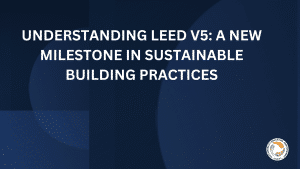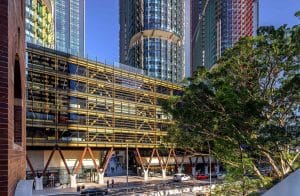As we all know, buildings have an enormous environmental footprint. Right from the design and construction to maintenance and operations, buildings consume huge amounts of valuable resources and generate massive amounts of waste. As people are gradually becoming more environment-conscious, this aspect of the building sector is being frowned upon by many.
This has led to the concept of green buildings. A green building is essentially one which uses fewer resources, has a lower carbon footprint, is energy-efficient, adopts eco-friendly practices and generates minimal waste.
Sustainable Technology
Broadly, sustainable technology covers everything from net zero buildings to energy-efficient appliances. In modern times, sustainable technology is more advanced than ever before. While it is super beneficial for the planet, it is not too demanding on your pocket too. This is because while green technologies like solar power might seem a bit expensive when you look at the upfront costs, they help you save substantially on energy bills in the long run.
Mentioned below is a list of latest and most promising sustainable technologies that are determined to make the building sector more environment-friendly.
Zero Energy Buildings
Generally speaking, a zero energy building produces enough renewable energy to meet its own annual energy consumption requirements, thereby reducing the use of nonrenewable energy in the building sector. These buildings even direct surplus energy back into the power grid. In most cases, wind power technology is used and it is highly common in skyscrapers whereby wind turbines are mounted at the rooftops. This definition also applies to campuses, portfolios, and communities.
Cool Roofs
Cool roofs are specially designed to offer increased solar reflectance and decreased thermal emittance. In other words, they reflect more of the sun’s rays than your average shingle roof, and prevent the warm or cool air inside from escaping through the top of a building. Under the intense heat of the summer sun, dark shingle roofs can reach temperatures of 150 degrees Fahrenheit. The reflectance of a cool roof can cut that down by more than 50 degrees.
Water Efficient Technologies
There are several water efficient technologies used, which are all part of sustainable construction technologies. Essentially, the technologies encompass re-use and application of efficient water supply systems. Examples include the use of dual plumbing, gray-water re-use, rainwater harvesting and water conservation fixtures. In urban areas, the technologies intend to lower water wastage by 15% to address freshwater shortages.
Green Insulation
When it comes to building insulation, the options can be overwhelming, particularly for owners who want to decrease their carbon footprint. The first example would be cellulose. Cellulose fiber insulation is the oldest form of insulation, and can be added to enclosed walls and unfinished attic floors as loose-fill, dense-packed or wet spray.
Another example is denim insulation. A form of cellulose fiber (cotton), denim insulation contains the same advantages of recycled paper. Made of the scraps and clippings from denim manufacturing facilities, recycled denim insulation can be used in place of fiberglass between open roof rafters, ceiling joists and wall studs.
Cork is another completely natural and renewable resource that can be used as a green insulator and is made of the outer bark of oak trees that have reached a minimum age of 18 years. Using the same geothermal properties as double-glazed windows, the air which fills the space between the cork’s cells makes it an excellent insulator.
Similarly, there are many other eco-friendly options when it comes to green insulation.
Biodegradable Materials
Since construction is all about building something new, we sometimes forget about the flip side of the coin – tearing something down and disposing of building materials. Biodegradable materials can change that disposal process into something more eco-friendly. Instead of a giant scrap heap of waste products and chemicals, they result in products that degrade naturally without contaminating the soil. An excellent example is the biodegradable paint.
Solar Power
Solar power is one among the most common sustainable green building technology used today. Primarily in green construction, it is being utilized in the following two ways:
Active Solar Power – This system is the use of functional solar systems which absorb the sun’s radiation to provide for heating and electricity provision. It helps in reducing the need for gas or electricity. While the upfront installation costs are higher in such systems, in the long run it saves on energy bills and also aids in reducing greenhouse gas emissions from non-renewable energy sources like fossil fuels.
Passive Solar Power – This design uses the sun’s rays to warm homes through the strategic placement of windows and the use of heat-absorbing surfaces. The windows allow energy in and the heat absorbed reduces the need for warming the house during cold winter months.
Energy Efficient Appliances
Do you know that electrical appliances account for over 30% of your monthly energy bills? This is why a lot of people have shifted their focus to investing in energy-efficient appliances. Energy efficient appliances are designed to utilize minimum energy to complete the required task. SmartGrid refrigerators, washing machines, dishwashers, micro oven are examples of such technologies.
Sustainable Resource Sourcing
Sustainable resource sourcing ensures the use of construction materials designed and created from recycled products and have to be environmentally friendly. Overall, the materials are remanufactured, recycled, recyclable, and obtained from sustainable sources.
Green Building Materials
Now that we have talked about various sustainable technologies used in the construction of buildings, let us also look at the green building materials readily available around us that make our buildings sustainable in the truest sense of the word.
Also read:
New Energy Trends for Green Buildings
Green Building Certification Programs 2020
Bamboo
Underutilized for many years, bamboo has long been used as a traditional building material and is gaining more spot-light recently due to its potential for eco-friendly purposes in green construction.
Bamboo produces more oxygen and absorbs more carbon dioxide, which is very ideal in combating global climate change. Apart from that, bamboo is easily grown and harvested, making it one of the most cost-effective construction materials to date. Bamboo is also highly sustainable and gives an aesthetic appeal in construction for housing.
Recycled Plastic
Plastics are one of the most energy-efficient materials over their entire life-cycle. The fact being that the typical lifespan of plastic applications in building and construction is up to 30 to 50 years.
Rammed Earth Brick
Rammed earth is an ancient construction technique similar to adobe that uses the raw materials of the Earth to form sturdy buildings through a simple process. The density of rammed earth makes it an ideal material for regulating the temperature of a building. It will stay cool in the summer and warm in the winter, and constructing rammed earth produces fewer emissions than the typical building process.
Wood
Wood is a historic, classic and durable green building material that has longevity, and has been adding aesthetics and flair to buildings for thousands of years. Using wood as a material in building construction can have significant environmental benefits. Manufacturing wood for construction is less energy intensive than other materials, including concrete, steel, cement or glass production with some percentage of recycled material. The finished product also has lower embodied energy.
Straw Bale
Unlike other recycled materials, straw bale can be used in its raw state -requiring no further processing and is quite affordable. By utilizing straw bale, the building will naturally provide very high levels of insulation to tackle climate change. Straw bale is a low impact, low carbon building material that has gained more mainstream acceptance recently. However, areas with extreme humidity and high rainfall may not be an appropriate choice for straw bale construction.
Grasscrete
Also known as “Sustainable Urban Drainage”, Grasscrete is a green alternative to standard concrete surfaces for parking lots, driveway and other access roads giving drainage benefits and improving storm-water absorption. Grasscrete is beneficial for businesses and developers because it drains at about the same rate (90%) as would an ordinary lawn in the same location. With 47% concrete and 53% holes filled with grass, it will help to form a natural bio-filter to significantly remove pollutants.
HempCrete
Made using the woody, balsa-like interior of the Cannabis sativa plant combined with lime and water, HempCrete material provides a natural airtight yet breathable and flexible insulation. HempCrete is also mold free and pest resistant as well as nearly fireproof. Considered as a sustainable building material, hemp can be grown and replenished relatively quick.
#1 LEED Exam prep now available with money back guarantee. Pass the LEED Exam like a Pro! Register now
Mycelium
Mycelium, a concrete which is capable of organic self-healing, reduces the need for high price repairs. It’s an eco-friendly insulation material that outperforms traditional fiberglass. Mycelium will be a major step for biomass green building materials.
Ferrock
Ferrock, a carbon-negative cement alternative which offers a stronger and greener alternative to standard cement manufacturing methods helps reduce a significant amount of carbon emission between fuel burning to running cement mixers and chemical processes. Any structure that is made with Ferrock cement will inevitably be longer-lasting and will not need repairs and replacement. The list of eco-friendly benefits of this green cement goes on.
With inputs from:
http://www.asiagreenbuildings.com/14221/green-building-material/











